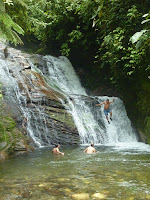

Our time in the Colombian Caribbean ended up being an action packed two weeks of scuba diving, jungle trekking and beach appreciation in the beautiful Tayrona National Park. We whetted our appetites for diving by spending five days in the quirky fishing village turned 'diving ghetto' of Taganga near Santa Marta, Colombia. This small dusty village was solely the haunt of Colombian fishermen a mere five or so years ago before the tourism and diving boom. We embarked on our Open Water certification with the lovely Ximena from Octopus Dive Centre who put us at ease and had us qualified in no time at all. We were particularly enamoured with the pufferfish and moray eels on offer as well as the myriad of tropical fish!






After four days of deep sea dips we decided to embark on the sweaty, bug infested jungle trek to Ciudad Perdida in the Sierra Nevada de Santa Marta mountains. The trek is only 44 kms return but winds through campesino plantations of coffee, cacao, corn and sugar cane, before crossing the ancestral grounds and villages of the fascinating Kogui indigenous people. The Kogui´s unusual lifestyle includes segregated living for men and women and a complex spiritual belief system led by shamen that venerates Mother Earth. They are reputed to be one of the last remaining pre-Colombian peoples in South America and still live in isolated villages in the mountains. We were fortunate to encounter many Kogui´s in their cream coloured smocks and wellie boots (their one modern concession) along the trail.






After four days of deep sea dips we decided to embark on the sweaty, bug infested jungle trek to Ciudad Perdida in the Sierra Nevada de Santa Marta mountains. The trek is only 44 kms return but winds through campesino plantations of coffee, cacao, corn and sugar cane, before crossing the ancestral grounds and villages of the fascinating Kogui indigenous people. The Kogui´s unusual lifestyle includes segregated living for men and women and a complex spiritual belief system led by shamen that venerates Mother Earth. They are reputed to be one of the last remaining pre-Colombian peoples in South America and still live in isolated villages in the mountains. We were fortunate to encounter many Kogui´s in their cream coloured smocks and wellie boots (their one modern concession) along the trail.




After three days of bug bites, waterfalls and nine river crossings we climbed the final 1,200 (!!!) stone steps to the first series of rounded green terraces that make up The Lost City. The 1,100 year old ruins were drenched in unruly vines, tropical flowers and moss, which combined to make this archaeological site the most magical we have visited on our trip. Not one 'do not do X, Y or Z' sign impeded our exploration or cluttered our photographs. We spent the morning exploring and were bemused by the ever present Colombian military perched with large machine guns all around the site. The day was beautiful and the trek was worth every last buggy, muddy step!
In an effort to sooth our bites and aching muscles we deemed it prudent to visit the renowned Tayrona National Park for a spot of hammock camping. The park and beaches were stunning and the monkeys were in attendance as we meandered through the park. The only thing we hadn´t banked on was the small detail of it being a long weekend, and as such the normally placid campground was a tent ghetto of televisons, spaced out backpackers and Colombian families on holiday from Cartagena. We still managed to find a slice or two or paradise, some excellent snorkelling and a cerveza or three. After two blissful days of sun and sand we packed up and headed for the colonial gem that is Cartagena.












Cartagena was a bouganvillea bonanza, fortified colonial gem with vivacious Caribbean flair. We loved the food, the Cubanesque music, the street performers, the architecture and the gold leafed chocolate treats. It was the perfect fuel to walk the perimeter of the fortified wall and take in the Tall Ships in the harbour that we imagined to be captained by pirates! It was one of our favourite cities on the continent and we were sad to be waving goodbye to South America after 10 magical months, as we boarded the twin-prop plane to Panama city.






























